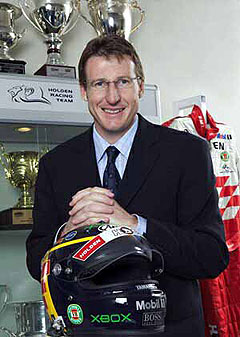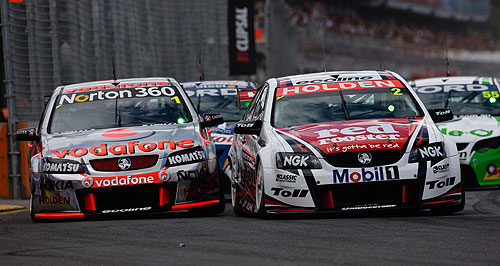Make / Model Search
News - General NewsV8 Supercars look to end two-horse raceWhat might be: V8 Supercars Australia presented this mock up image of a Nissan Maxima and Hyundai Grandeur as what its future might look like with more manufacturers. Chrysler, Nissan take a peek at V8 Supercar ‘Car of the Future’ format for 201229 Mar 2010 V8 SUPERCARS Australia has thrown open the door to more manufacturers to compete in the nation’s biggest motor racing series from 2012, but at the risk of alienating the series’ long-time supporters, Holden and Ford. The rule book for the 17-year-old series has been rewritten under a 'Car of the Future' blueprint with the aim of not only cutting costs for V8 Supercar teams but also making it feasible for importers to throw their hat in the ring. While no new manufacturer has yet put up its hand to join the series, at least two – Nissan and Chrysler – had observers at today’s media briefing in Melbourne. Such manufacturers will have 18 months to consider their options between the time the full rules are released in the middle of this year to the start of the new era of racing in January 2012. Speaking after today’s media presentation, Chrysler’s public relations manager Jerry Stamoulis said Chrysler was “just interested to see what’s going”, although it was not planning to jump into V8 Supercars in the short term. However, he did not rule out such a move in future, saying: “As we grow our business, if there is an opportunity that we can get involved in something that suits our product plan, then maybe there is something we can do. “At this stage it (attending the presentation) was more out of interest rather than moving into something any time soon.” Chrysler Australia, which supplied pace cars in a high-profile sponsorship for the V8 Supercar Series from 2006 to 2008, has a ready supply of suitable V8 engines and appropriate cars, such as the 300C, for such an entry, should it decide to proceed.  Left: V8 Supercar director Mark Skaife. Left: V8 Supercar director Mark Skaife.Mr Stamoulis said Chrysler would be happy to receive an approach from V8 Supercars. “I thought the ideas Mark (Skaife) and Tony (V8SA chairman Tony Cochrane) have in mind will be fantastic for the sport and I think they are moving in the right direction,” he said. Likewise, Nissan brand manager Darren Holland, who also attended to event, described the rule changes as a positive step forward. "V8 Supercars has set itself up as an exceptional sport and entertainment platform,” he said. “From our point of view, we don’t really have any plans on the future and what we will do with it, but we will have a look and see how we go.” Nissan was a giant of Australian touring car racing 20 years ago, when its turbo-charged Nissan Skyline GT-R "godzillas" reigned supreme before the demise of Group A regulations brought it to an end. The Car of the Future blueprint – drawn up by five-time Australian touring car champion Mark Skaife and approved by the V8 Supercars board and teams – allows for manufacturers to enter cars with any naturally aspirated V8 engine, as long as they can bring it into performance parity with the existing Ford and GM pushrod V8s that generate about 478kW of power and 900Nm of torque. However, Holden motorsport manager Simon McNamara fears the move to expand manufacturer involvement from the current two participants will drive up costs through fiercer competition. “They (other manufacturers) will only come in to win,” he told GoAuto today. “Any team that gets a new manufacturer will need to spend money. In any business case or pure mathematics, in motor racing, money wins. “The more money you have got, the more chance you have of winning the race.” Mr McNamara said the common experience in all categories of racing around the world in which new manufacturers had entered, costs had gone up. “For the past five years, we have been trying to reduce the costs,” he said. “We are very happy with the blueprint, in terms of cost reduction, but adding other manufacturers could send costs skyrocketing again.” Both Holden and Ford have cut the number of teams they support over the past few years in line with trimmed marketing budgets. According to figures presented by Mark Skaife in today’s media announcement, top-flight teams capable of winning races spend about $8 million a year on their two-car teams – double what they were spending in 1994. By comparison, he said, the cost of showroom cars had appreciated just 28 per cent in that time. Mr Skaife said the target of the new rules was to reduce the cost of a V8 Supercar ‘rolling chassis’ – basically the car minus the drivetrain – to $250,000 per unit, making it feasible for teams to build spare cars so they could more easily deal with a two-week turnaround between events. He said V8 Supercars also wanted to halve the cost of each engine from the current $100,000 to $50,000, while also cutting running costs. But he said the new rules represented an evolution of the current set-up, not wholesale change. “This is evolution, not revolution,” he said. V8 Supercar technical staff researched race engines around the world and, according to Mr Skaife, most comparable engines were cheaper to run per kilometre than the existing V8 Supercar engines. The engines listed in the presentation were all produced by independent race engine suppliers, such as Ilmor, Judd and Sodemo, with some based on production engines, such as GM’s LS7 ‘crate engine’, while others were bespoke powerplants. Under the new rules, V8 engines will still be mandatory, as well as normally aspirated. However, they could include more modern features such as double overhead camshafts and alloy blocks. Details of a so-called ‘engine equalisation program’ to ensure parity are still being drawn up and should be ready by June. Engines do not necessarily have to be sourced from the particular manufacturer, and might even be drawn from a rival company and ‘badge engineered’ by simply replacing the rocker covers. All cars will be built on a common ‘Project Blueprint’ platform, with a 90 per cent common roll cage and with a common independent rear suspension, replacing the old-style ‘live’ rear axle. Safety will be improved, with the fuel tank being moved forward of the rear axle and the drivers’ seat shifted further towards the centre of the car for side impact protection. Polycarbonate windscreens will be introduced. Cars must be rear-drive, four-door sedans, which rules out two-door supercars such as the Nissan GT-R and European exotics. The number of ‘control’ parts is to be increased as a method of driving down costs, with a new 18-inch wheel – up from 17 inches – one of those to be mooted today. Mr Cochrane said that if the Car of the Future project delivered nothing more than more cost-effective V8 Supercar racing, he would be happy. He said the intent was not to upset Holden and Ford but to protect the viability of all stakeholders and to retain “terrific, exciting V8 Supercar racing”.  Read more |
Click to shareGeneral News articlesResearch General News Motor industry news |










Facebook Twitter Instagram